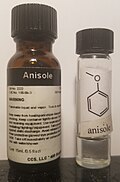アニソール
アニソール (英語: anisole)またはメトキシベンゼン(英語: methoxybenzene)は、アニスの実に似た快い香りを示す有機化合物で、外見は無色の液体。ベンゼンの水素を1個メトキシ基 (–OCH3) に置き換えた構造 (C6H5OCH3) を持つエーテルである。消防法に定める第4類危険物 第2石油類に該当する[2]。
| アニソール | |
|---|---|

|

|

| |
別称 Methyl phenyl ether[1] Phenoxymethane | |
| 識別情報 | |
| CAS登録番号 | 100-66-3 |
| PubChem | 7519 |
| ChemSpider | 7238 |
| UNII | B3W693GAZH |
| EC番号 | 202-876-1 |
| 国連/北米番号 | 2222 |
| KEGG | C01403 |
| ChEBI | |
| ChEMBL | CHEMBL278024 |
| RTECS番号 | BZ8050000 |
| バイルシュタイン | 506892 |
| Gmelin参照 | 2964 |
| |
| |
| 特性 | |
| 化学式 | C7H8O |
| モル質量 | 108.14 g mol−1 |
| 外観 | 無色の液体 |
| 密度 | 0.995 g/cm3 |
| 融点 |
−37 °C, 236 K, -35 °F |
| 沸点 |
154 °C, 427 K, 309 °F |
| 溶解度 | 不溶 |
| 磁化率 | −72.79×10−6 cm3/mol |
| 危険性 | |
| GHSピクトグラム |  
|
| GHSシグナルワード | 警告(WARNING) |
| Hフレーズ | H226, H315, H319 |
| Pフレーズ | P210, P233, P240, P241, P242, P243, P264, P280, P302+352, P303+361+353, P305+351+338, P321, P332+313, P337+313 |
| NFPA 704 | |
| 半数致死量 LD50 | 3700 mg/kg (rat, oral) |
| 特記なき場合、データは常温 (25 °C)・常圧 (100 kPa) におけるものである。 | |
アニソールでは、メトキシ基の共鳴効果による電子供与性によりベンゼン環の電子密度が高められており、求電子的反応に対し、オルト・パラ配向の大きな反応性を示す。例えば、無水酢酸とアニソールが反応すると、p-メトキシアセトフェノンが得られる。
アニソールと五硫化二リン(分子式 P4S10)が反応するとローソン試薬を生じる。これは有機化合物上の酸素を硫黄に交換する硫化剤として有力な試薬である[3]。
アニソールは香料、または合成中間体として用いられる。アニソール自身は昆虫のフェロモンの一種でもある。
参考文献
編集- ^ a b c Nomenclature of Organic Chemistry: IUPAC Recommendations and Preferred Names 2013 (Blue Book). Cambridge: The Royal Society of Chemistry. (2014). pp. 702–703. doi:10.1039/9781849733069-00648. ISBN 978-0-85404-182-4. "Anisole, C
6H
5–O–CH
3, is the only name in the class of ethers which is retained both as a preferred IUPAC name and for use in general nomenclature. For preferred IUPAC names, no substitution is allowed; for general nomenclature substitution is allowed on the ring and on the side chain under certain conditions (see P-34.1.1.4)." - ^ 法規情報 (東京化成工業株式会社)
- ^ Thomsen, I.; Clausen, K.; Scheibye, S.; Lawesson, S.-O. "Thiation with 2,4-bis(4-methoxyphenyl)-1,3,2,4-dithiadiphosphetane 2,4-disulfide: N-methylthiopyrrolidone." Org. Synth., Coll. Vol. 7, p. 372 (1990); Vol. 62, p. 158 (1984). オンライン版
